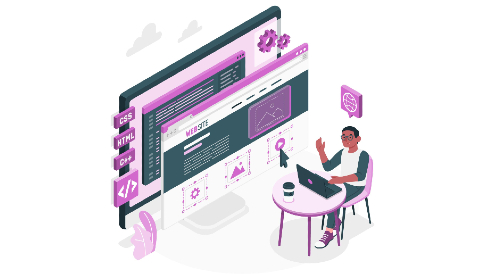The Importance of User Experience in Web Design
Digital marketing has become essential to the growth of businesses in the modern era. Every business now must have a solid online presence, including a robust social media profile and a well-crafted website. You can introduce your business through your website and make a sales pitch to your customer within minutes. You can also host an online store and increase your sales. Your website can also help you with digital marketing strategies. For example, you can have a blog for content marketing, and pages on your website can make great landing pages for your sales funnel. To make a great website, you must focus on making it user-centric. Ensure you prioritize the user experience in web design.
If you want to outsource, make sure to check the best web design Greenville offers and let experts handle your UX. Let’s discuss why UX is critical to your web design process and what techniques you should pursue to make your design more user-friendly.
Principles of UX Design
UX is based on principles. The better your design meets these standards, the better the user experience:
- User-Centered: When you beta-test your website, put yourself in the shoes of a user who knows nothing about your company. Ask yourself if your website design effectively answers such a user’s queries.
- Consistent: Your design must be consistent across all web pages and all page sections, or it will confuse the users. Use the same fonts, color palette, and tone for the entire website.
- Accessible: Ensure various customers can access your websites conveniently, even if they are differently abled. For example, consider putting alt-text on your images so assistive technology can describe them for visually impaired individuals.
- Hierarchy: In UX, you must focus on two types of hierarchy: information architecture and visual hierarchy. Information architecture really is your navigation: the more important pages should take fewer clicks to land on. Visual hierarchy means you should place the important details on the top of the page and make them more prominent.
- Intuitive: Elements of your design should be straightforward and intuitive. Use a common-sense scheme for your navigation, or underline and change the color of your hyperlinks.
- Responsive: Your design should respond to different devices, and it should retain its functionality consistently on mobile phones, tablets, and PC browsers. As such, it’s important to research desktop UX designs while also keeping a close watch on the most impactful mobile-focused equivalents so that you can join the dots between the two.
- Fast: Your design should not be too heavy so that it is easy to load. Ensure fast loading times across platforms.
- Concise: Do not bombard the customer with information and walls of text, as that will make it difficult for them to find relevant information. Stay clear, concise, and relevant.
- Aesthetically Pleasing: A significant portion of UX design is your website’s appearance. Your website must look warm, welcoming, and beautiful.
How UX Improves Your Business
An optimized UX can help your business in several ways.
Increased User Engagement
Users must easily navigate your website and find what they are looking for. Otherwise, they will get frustrated and may just close your website. A UX-focused web design provides users with an intuitive interface that anyone, regardless of tech-savviness, can easily explore. A well-designed website will also promote exploration. If the users find it easy to navigate your website, they will spend more time looking at its different sections and increase user engagement.
More Conversions
In digital marketing, your primary goal is to increase the conversion rate; that is, how many users who visit your website take a desired action, like subscribing to your newsletter or buying a product. A UX-focused web design can increase your conversions by 400%. A well-planned website will have prominent calls to action (CTAs), which are website buttons encouraging the user to take a specific action, increasing the likelihood that users will interact with them. Similarly, your checkout processes will be simplified, decreasing the likelihood of abandoned carts.
Search Engine Optimization
A well-designed website also helps with SEO: Google’s algorithm prefers user-friendly websites with slower load times. The algorithm also prefers websites with a longer dwell time – the time a user spends on a particular website. Sites with a longer dwell time rank better. As UX increases customer engagement, an average user spends longer on your website, increasing your site’s dwell time and rankings.
Decreased Bounce Rate
Your website’s bounce rate is the ratio of visitors who leave a website after viewing just one page. Mostly, this is because they did not find what they were looking for or felt the website wasn’t credible. You will see a lower bounce rate if your website incorporates solid UX practices. As your navigation improves, individuals are more likely to find out which page they should visit to find what they came looking for. Your navigation should be straightforward and intuitive.
A good UX design also adds to your credibility and makes your business look trustworthy. In contrast, if your website lacks a user-friendly design, visitors are less likely to trust your website and will leave right away.
More Credibility
A well-designed website can improve how people perceive your brand: having a professional and convenient web design makes your brand look more trustworthy. A UX design requires consistency. If your color palette, font, and other elements are consistent, it suggests a cohesive and strong brand identity and puts forward strong brand identity. It also helps differentiate your business from competitors by making your design more memorable.
Competitive Advantage
If your website has a UX-optimized design, it has a competitive advantage in the market. A website designed with users in mind focuses on making your business accessible to differently-abled individuals. Consequently, you gain a competitive advantage in that demographic. This design also helps retain customers, giving you an advantage over your competitors. As your customers will have a good experience due to your focus on UX, they are likely to revisit your site if they need a similar service.
Endnote – User Experience in Web Design
Your website informs users about your business and is an integral element of your digital marketing strategy. You should pay close attention to its design. Ensure you follow UX design principles, including accessibility, conciseness, intuitiveness, and consistency. Your website should follow these principles to be user-centric. A UX-based design will help your business, leading to more user engagement. This will decrease the bounce rate and increase conversions, ultimately increasing your customers. It will also help your website rank better in Google’s algorithm, ensuring more people can find your website.




Leave a Reply